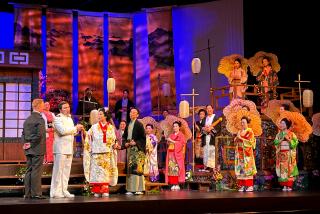O.C.’s Alternative Theater Thrives by Sticking to Basics
SANTA ANA — When they started out, they promised: No Neil Simon, no Rodgers & Hammerstein, no Kaufman & Hart.
Now, on the eve of their fifth season, which opens Friday with a revival of “The Glass Menagerie” by Tennessee Williams, they can boast that they’ve kept their promise.
More important, they have survived and thrived.
And they’ve done it on the classic plays of Sartre and Beckett, Wilder and Cocteau, Aristophanes and Ibsen, in a small storefront theater tucked away in a tiny industrial mall.
“We feel real wise,” Patricia L. Terry said recently about the plucky success of the Alternative Repertory Theatre. “We’ve solved a lot of problems. We’re not only here, we can accurately predict we’ll be here again next year.”
During a recession, when theater companies everywhere are facing some of their worst fiscal nightmares, a prediction like that would seem to be tempting fate.
But Terry, who is ART’s founding artistic director, believes that tough economic times have even helped steer the theatergoing public to the ART box office because of its relatively low ticket prices.
A subscription to an entire ART season, she points out, goes for less than a single prime-location ticket at the Orange County Performing Arts Center.
“People are looking to stretch the value of their entertainment dollar, and we’re affordable,” said Terry, noting that ART subscriptions have already risen 50% over last year, from 180 to 270, with more than a month to go before they complete the current sales campaign. “We feel we’re the best ticket value around.”
A three-play subscription for the ART 1991-92 season comes to $39. The top-priced single ticket is $15. The top for a musical in OCPAC’s Broadway Series is $44; for a play on the South Coast Repertory Mainstage, the top is $32.
Of course, such comparisons must be weighed against the fact that ART doesn’t come anywhere close to offering the production size or opulence at those venues. And yet theater style is such a variable artistic commodity that larger and grander is not necessarily better.
“One of the things we’ve learned over the years--and this is where the wisdom comes in--is how to distill a piece down to its most basic elements so it can fit on our stage. We’ve become very adept at that. We spend weeks and months conceptualizing a piece before we even get into rehearsal, many times before we even think about casting.”
Terry and her associates--ART co-founders Kathleen Bryson, David Palmer and Gary Christensen--have also learned how to work within a pocket-size budget. They expect to spend about $45,000 (all but 20% to be earned at the box office) on the entire three-play season.
In addition to “The Glass Menagerie,” they’ll stage “Brecht on Brecht,” an evening of excerpts from the work of Bertolt Brecht (Jan. 17 to Mar. 14, 1992), and Shakespeare’s “The Tempest” (April 17 to June 13).
Even more than budgetary restrictions, Terry says, the space limitations of ART’s 61-seat theater have helped define the style and choice of material. In fact, the design elements of the 15 or so plays staged there since 1987 have proved to be the most consistently imaginative aspects of the productions.
Coming up with the proper design, however, can mean dealing with very mundane questions. “The Glass Menagerie” requires a dining room table, for instance, and two meals to be served. “We looked at the script,” said Terry, who is directing the play, “and we asked, ‘Is there any way to eliminate that (table)? It sure would be nice if we could.’ We finally decided there just wasn’t, because it’s integral to the action.”
OK, what had to be eliminated? “A row of seats,” she said, to make room for the table. “But does it matter what they eat? No. It’s not important. So we decided to go without serving food. It makes things easier, more practical.”
On the other hand, they have gone to great pains to design elaborate sets and costumes for some shows, such as Edward Albee’s “Seascape” and Thornton Wilder’s “The Skin of Our Teeth.”
“We believe real intensely in our artistic mission,” Terry said, “which is putting on theater of worth in language and ideas. To that end we’ll do as much as we’re able. We’re incredibly tenacious, but we’re also real flexible. If something isn’t working, we’ll drop it.”
ART proved that last year. It launched a “Directors Fest”--intended to foster young stage directors--and killed the project when nobody responded. It also dropped a series of staged readings--meant to develop original plays--when it was inundated with more scripts than it could possibly look at, let alone cultivate.
Tenacity and flexibility also helped ART survive a fiscal crisis that nearly forced it to disband in 1989. Now, Terry maintains, the troupe faces the much happier prospect of long-term growth.
“We’re definitely in a growth phase,” she said. “There’s absolutely no question of it. Optimally, we’re looking at doubling our season subscribers this year. That’s a goal we’ve set.”
If ART succeeds in that, Terry believes, it will be well on its way to doubling the number again the following year to 800 subscribers.
“It’s conceivable,” she said. “And when that happens, we’re going to get a larger space. A theater with 150 to 200 seats would be nice. We’re already looking.”
* “The Glass Menagerie” previews Thursday and opens Friday at the Alternative Repertory Theatre, 1636 S. Grand Ave., Santa Ana. Performances are Thursdays to Saturdays at 8 p.m.; Sundays at 7 p.m. through Nov. 26. Tickets: $10 (previews); $12.50 to $15 (regular run). Information: (714) 836-7929.
More to Read
The biggest entertainment stories
Get our big stories about Hollywood, film, television, music, arts, culture and more right in your inbox as soon as they publish.
You may occasionally receive promotional content from the Los Angeles Times.










